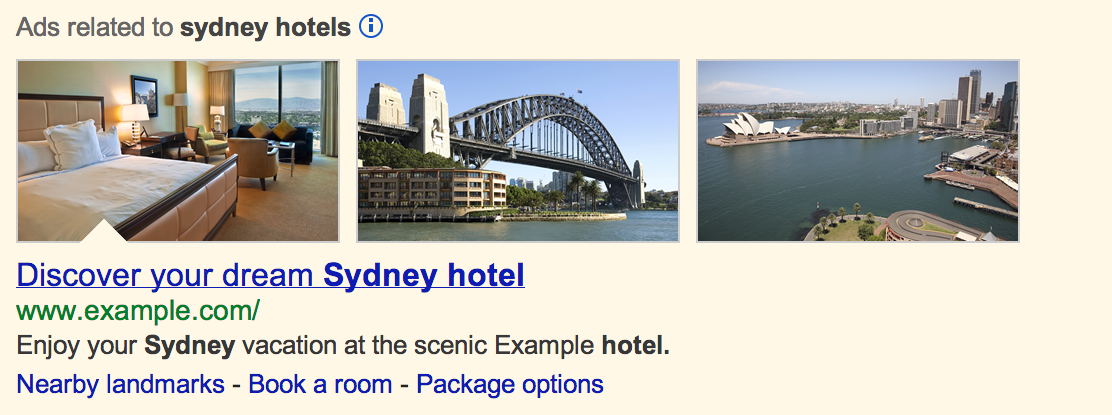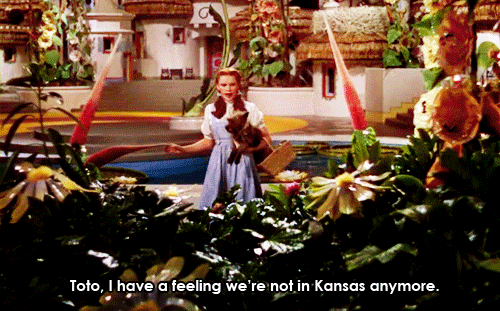The PPC world has been humming with discussion (and speculation) since Google made a big splash with their announcement that AdWords would now allow image extensions. No, images in search results are not new, and they’re not even particularly new within paid search ads (ever heard of PLAs?).
But for search marketers who have been creating little green and blue ads that have looked more or less the same since what seems like the beginning of time? Seeing PPC ads that look like this:

Kind of feels like this:

Obviously, with these shiny new ads there will be a temptation to make EVERYTHING all pretty and image-y, but beware: Reports are already surfacing about Google being very finicky about what sorts of images “qualify” for use in the image extensions.
Beyond the baseline requirements that the images be high-resolution, in a 16:9 aspect ratio (hmm…), and other specifications, Google is also enforcing keyword relevancy—which makes us wonder if they’ve doubled their ad review team in preparation for this extension. Because that’s what it seems like it would take to ensure uniform compliance with their stated standards of beauty and relevance.
Here are four quick tips based on these beta specs:
- Try creating separate ad groups for your image ads. That way you can fine-tune your keywords, your ad copy, and your images to work in perfect harmony, as they should.
- Reconsider the value of bidding for those top spots. As with any AdWords extension, images can only be applied to the top spots, and our money (literally) says that this extension might be the worst culprit yet when it comes to inflating those values.
- Don’t count on tracking image clicks. Like any other AdWords Extension, Google is refusing to provide analytics about which part of the ad a user clicked on—so clicks on images won’t be tracked separately.
- Identify your highest-value verticals and focus image experiments there. Not every vertical will be appropriate for image ads, so conserve your efforts rather than just plastering images everywhere just because you can. (This is discussed further below.)
AdWords Image Extensions: When to Use Them
By now you’ve likely heard that overt brand images aren’t allowed (you’ll have to find more creative ways to sneak your logo in), and neither are gifs or other lowbrow tricks. But here’s the question no one seems to be asking: When would you actually want to use an image in your ad, and more importantly when wouldn’t you?
Obviously you know your account better than anyone, but let us be the first to say it: Just because something is possible doesn’t mean you have to do it! If all your friends threw their ads off a bridge would you do it too?
The verticals and strategies for which Image Extensions are a golden opportunity are fairly obvious:
- Travel ads: Nothing sells a vacation like a picture of the beach.
- Luxury ads: Google is pressing hard for pretty pictures, and nothing takes a prettier picture than a pretty thing.
- Anything aspirational: Have something people want? A picture is worth a thousand jealous words (see above).
- Product ads: Forget marketing—product images are actually a valuable resource for the end user. There’s a reason images started in PLAs.
- Huge budgets: You’ll hear plenty of small brands and local shops complain that the inflated bids and beauty requirements associated with these images unfairly favor big companies with massive ad budgets. And they’re right.
Less obvious are the situations in which you might want to take a pass on an image ad extension. Here are a few examples:
- If you don’t have a great image. Want to hear a bold prediction? Somewhere down the road, ugly images are going to sneak into the top spot of Google’s search results. And they won’t help the ad they’re associated with–they’ll hurt it. And maybe hurt the brand, too. So if you don’t have a truly attractive image, wait until you do.
- If what you’re selling isn’t a thing. Yes, we will see plenty of extremely creative executions via these new image extensions. But sometimes including an image just doesn’t make sense. Selling septic tank installation? How about tax preparation? If so, maybe it’s best to focus on your headline.
- If your strategy extends beyond “bid for the top spot.” As mentioned above, image extensions have the potential to create quite the bidding war for that top spot (funny how Google always manages to do that, isn’t it?). But as the top of the results page starts to look more and more “like an ad” to the casual browser, the sidebar ads and non-image ads below it start to look more and more like organic search results. Or at the very least, less “like an ad.” So as with any upgrade, there is also value being created by way of opportunities to differentiate.
AdWords Image Extensions: How to Use Them
Obviously, Image Extensions are very, very new. So new, in fact, that they’re still in beta and open only to a limited number of special account holders. If you’d like to start experimenting, Google has a simple request form you can fill out here.
Otherwise you’ll have to wait until Google works out the kinks with the service. There are a few very general guidelines at the moment, which we detailed earlier in the form of high-resolution images and keyword relevancy, but at the moment it seems like Google is being much more selective and ad hoc about how they approve images.
Theoretically, they will have a longer and more robust list of guidelines and requirements for images once Image Extensions are released to the AdWords community in full.
Watch this space for further news and updates regarding this bold experiment as it grows and changes. Because they always do.




